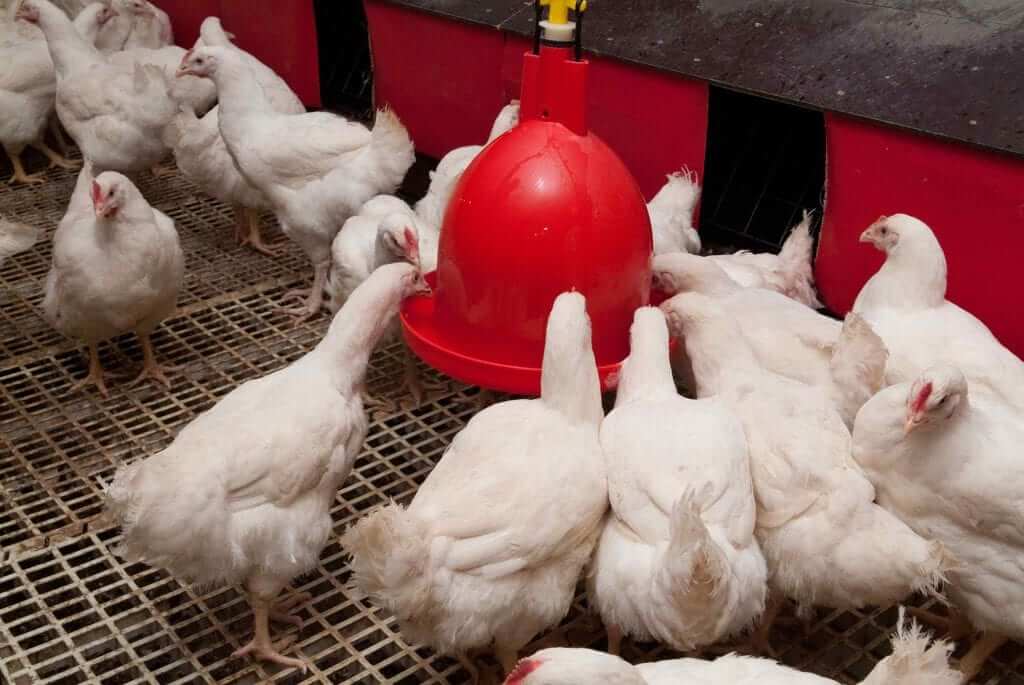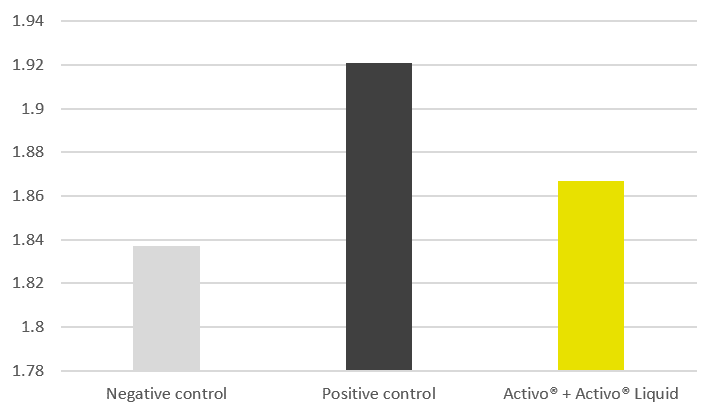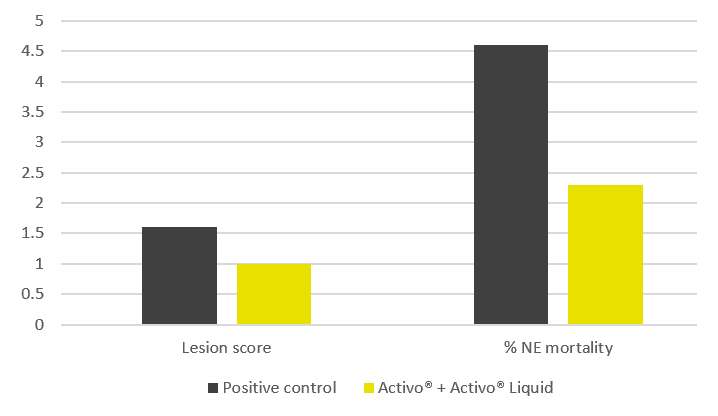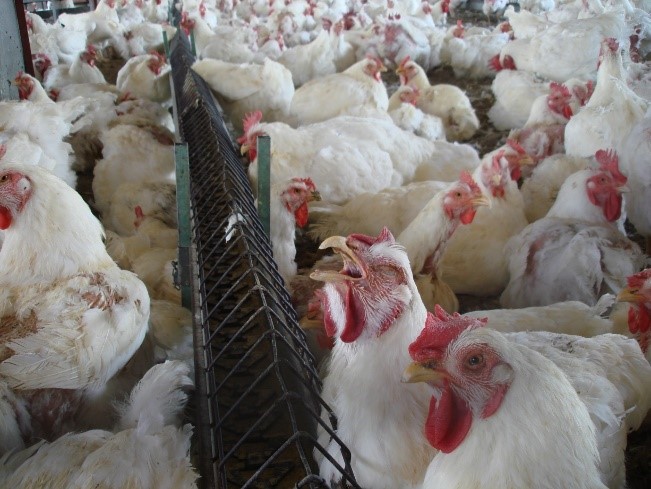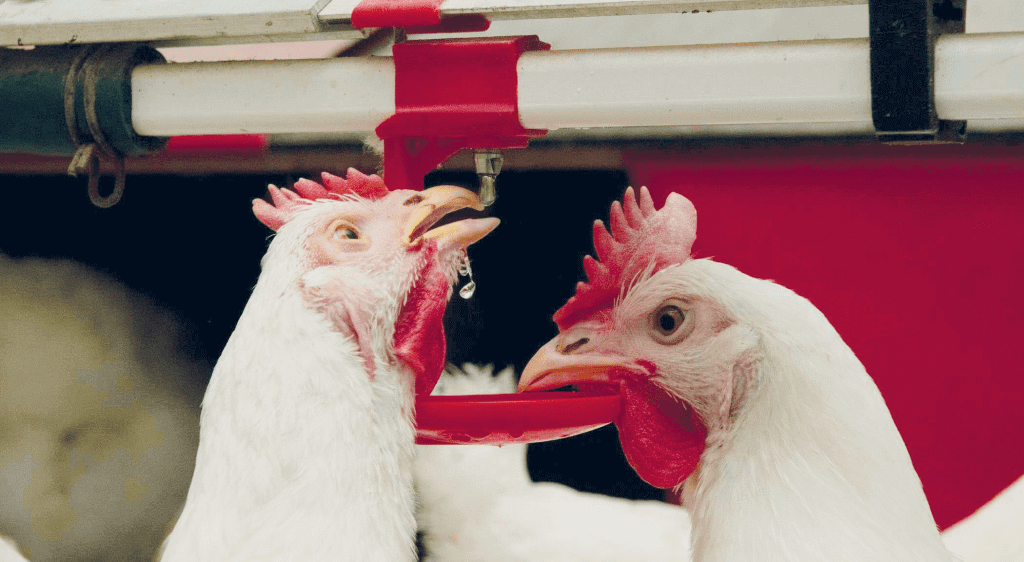Sub-therapeutic doses of antibiotic growth promoters (AGPs) were used for more than 50 years in poultry production to achieve performance targets – until growing concerns arose regarding antibiotic resistance (Kabir, 2009) and decreasing efficacy of antibiotics for medical purposes (Dibner & Richards, 2005).
Isolates of ESBL-producing E.coli from animals, farmworkers, and the environment were found to have identical multidrug resistance patterns (A. Nuangmek et al., 2018). There is also evidence that AMR strains of microorganisms spread from farm animal to animal workers and beyond. Global AMR fatalities are increasing and might reach 10 million by 2050 (Mulders et al., 2010, Trung et al., 2017, Huijbers et al., 2014).
In light of this, certain AGPs have already been banned, and there is a strong possibility of future restrictions on their use worldwide. Bans are effective: the MARAN report 2018 shows that lower antibiotics usage following the EU ban on AGPs has reduced resistant E.coli in broilers. Another positive consideration is the market opportunities that exist for antibiotic residue-free food.
However, the key element that poultry producers need to get right for antibiotic reduction to be successful is respiratory health management. This article looks at why respiratory health is a particular challenge – and how phytogenic solutions can help.
A closer look at the chickens’ respiratory system
The respiratory tract is equipped with a functional mucociliary apparatus consisting of a protective mucous layer, airway surface liquid layer, and cilia on the surface of the ciliated cells. This apparatus produces mucus, which traps the inhaled particles and pathogens and propels them out of the airways. This mechanism, called the mucociliary clearance, is the primary innate defense mechanism of the respiratory system.
High stocking density combined with stressful environmental factors can negatively influence birds’ immune systems (Heckert et al., 2002; Muniz et al., 2006), making them more susceptible to respiratory disease. When a bird suffers from respiratory disease, which is nowadays usually complicated by a co-infection or secondary bacterial infection, there is an excess production of mucus that results in ciliostasis and, therefore, in an impaired mucociliary clearance. The excess mucus in the tract obstructs the airways by forming plagues and plugs, resulting in dyspnea (hypoxia) and allowing the invasive bacteria to adhere and colonize the respiratory system.
The build-up of mucus in the respiratory tract severely reduces oxygen intake, causing breathlessness, reduced feed intake, and a drop in the birds’ energy levels, which negatively impacts weight gain and egg production. Respiratory problems can result from infection with bacteria, viruses, and fungi, or exposure to allergens. The resultant irritation and inflammation of the respiratory tract leads to sneezing, wheezing, and coughing – and, therefore, the infection rapidly spreads within the flock.
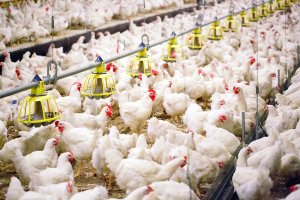 Relatively high stocking density is the norm in poultry production
Relatively high stocking density is the norm in poultry production
Low or no antibiotics: how to manage respiratory disease?
Unsurprisingly, respiratory diseases in poultry are a major cause of mortality and economic loss in the poultry industry. For Complicated Chronic Respiratory Disease (CCRD), for instance, although the clinical manifestations are usually slow to develop, Mycoplasma gallisepticum (MG), in combination with E. coli, can cause severe airsacculitis. Beside feed and egg production reduction, these problems are of high economic significance since respiratory tract lesions can cause high morbidity, high mortality, and significant carcass condemnation and downgrading.
Producers need to pre-empt the spread of respiratory pathogens, react quickly to alleviate respiratory distress and maintain the mucociliary apparatus’ functionality. Traditionally, treatment options are based on antiviral, anti-inflammatory, and antibiotic drugs. Can the poultry industry limit losses from respiratory infections without excessive recourse to antibiotics?
Indeed, a sudden reduction in antibiotic usage comes with a risk of impaired performance, increased mortality, and impaired animal health and welfare. The impact has been quantified as a 5% loss in broiler meat production per sq. meter (Gaucher et al., 2015). Effective antibiotics reduction requires a combination of innovative products and suitable consultancy services to manage poultry gut health, nutrition, flock management, biosecurity, and, particularly, respiratory health.
Non-antibiotic alternatives to control diseases and promote broiler growth, such as organic acids (Vieira et al., 2008), probiotics (Mountzouris et al., 2010), prebiotics (Patterson & Burkholder, 2003), and essential oils (Basmacioğlu Malayoğlu et al., 2010) have been the subject of much research in recent years.
Phytogenic solutions: proven efficacy
Essential oils, which are extracted from plant parts, such as flowers, buds, seeds, leaves, twigs, bark, wood, fruits, and roots, have a particularly well-established track record of medicinal applications. Efforts have centered on phytomolecules, the biologically active secondary metabolites that account for the properties of essential oils (Hernández et al., 2004; Jafari et al., 2011).
Studying these properties is challenging: essential oils are very complex natural mixtures of compounds whose chemical compositions and concentrations are variable. For example, the concentrations of the two predominant phytogenic components of thyme essential oils, thymol and carvacrol, have been reported to range from as low as 3% to 60% of the whole essential oil (Lawrence and Reynolds, 1984).
Another well-researched example is eucalyptus oil. The essential oils of eucalyptus species show antibacterial, anti-inflammatory, diaphoretic, antiseptic, analgesic effects (Cimanga et al., 2002) and antioxidant properties (Lee and Shibamoto, 2001; Damjanović Vratnica et al., 2011). The oils are mainly composed of terpenes and terpene derivatives in addition to some other non-terpene components (Edris, 2007). The principal constituent found in eucalyptus is 1,8-cineole (eucalyptol); however, other chemotypes such as α-phellandrene, ρ-cymene, γ-terpinene, ethanone, and spathulenol, among others, have been documented (Akin et al., 2010).
 Close-up of eucalyptus leaf oil glands and
Close-up of eucalyptus leaf oil glands and
the molecular structure of eucalyptol C10H18O (red = oxygen; dark grey = carbon; light grey = hydrogen)
Antimicrobial activity
In modern intensive broiler production, bacterial diseases such as salmonellosis, colibacillosis, mycoplasmosis, or clostridia pose serious problems for the respiratory system and other areas. Analyses of the antibacterial properties of essential oils have been carried out by multiple research units (Ouwehand et al., 2010; Pilau et al., 2011; Solorzano- Santos and Miranda-Novales, 2012; Mahboubi et al., 2013; Nazzaro et al., 2013; Petrova et al., 2013).
Phenols, alcohols, ketones, and aldehydes are clearly associated with antibacterial activity; the exact mechanisms of action, however, are not yet fully understood (Nazzaro et al., 2013). Essential oils’ antimicrobial activity is not attributable to a unique mechanism but instead results from a cascade of reactions involving the entire bacterial cell (Nazzaro et al., 2013). However, it is accepted that antimicrobial activity depends on the lipophilic character of the components.
The components permeate the cell membranes and mitochondria of the microorganisms and inhibit, among others, the membrane-bound electron flow and thus the energy metabolism. This leads to a collapse of the proton pump and draining of the ATP (adenosine triphosphate) pool. High concentrations may also lead to lysis of the cell membranes and denaturation of cytoplasmic proteins (Nazzaro et al., 2013; Gopi et al., 2014).
According to current knowledge, lavender, thyme, and eucalyptus oil, as well as the phytomolecules they contain, show enhanced effects when combined with other essential oils or synthetic antibiotics (Sadlon and Lamson, 2010; Bassole and Juliani, 2012; Sienkiewicz, 2012; de Rapper et al., 2013; Zengin and Baysal, 2014).
Minimum inhibitory concentration (MIC) of some essential oil components against microorganisms in vitro

Immune system boost I: improved production of antibodies
Some essential oils were found to influence the avian immune system positively, since they promote the production of immunoglobulins, enhance the lymphocytic activity, and boost interferon-γ release (Awaad et al., 2010; Faramarzi et al., 2013; Gopi et al., 2014; Krishan and Narang, 2014). Placha et al. (2014) showed that the addition of 0.5g of thyme oil per kg of feed significantly increased IgA levels.
Awaad et al. (2010) experimented on birds vaccinated with the inactivated H5N2 avian influenza vaccine. The experiment revealed that adding eucalyptus and peppermint essential oils to the water at a rate of 0.25 ml per liter resulted in an enhanced cell-mediated and humoral immune response.
Saleh et al. (2014), who applied thyme and ginger oils in quantities of 100mg and 200mg per kg of feed, respectively, observed an improvement in chickens’ immunological blood profile through increased antibody production. Rehman et al. (2013) stated that the use of herbal products containing eucalyptus oil and menthol in broilers showed consistently higher antibody titers against NDV (Newcastle disease virus), compared to untreated broilers.
Immune system boost II: better vaccine responses and anti-inflammatory effects
Essential oils are also used as immunomodulators during periods when birds are exposed to stress, acting protectively and regeneratively. Importantly, the oils alleviate the stress caused by vaccination (Barbour et al., 2011; Faramarzi et al., 2013; Gopi et al., 2014). The study by Kongkathip et al. (2010) confirmed the antiviral activity of turmeric essential oil.
In recent years studies have been carried out on the use of essential oils in conjunction with vaccination programs, including those against infectious bronchitis (IB), Newcastle disease, and Gumboro disease. The results of the experiments show that essential oils promote the production of antibodies, thus enhancing the efficacy of vaccination (Awaad et al., 2010; Barbour et al., 2010; Barbour et al., 2011; Faramarzi et al., 2013).
Essential oils contain compounds that are known to possess strong anti-inflammatory properties, mainly terpenoids, and flavonoids, which suppress the metabolism of inflammatory prostaglandins (Krishan and Narang, 2014). Also, other compounds found in essential oils have anti-inflammatory, pain-relieving, or edema-reducing properties, for example, linalool from lavender oil, or 1,8-cineole, the main component of eucalyptus oil (Peana et al., 2003).
Immune system boost III: antioxidant effects and radical scavenging
An imbalance in the rate of production of free radicals or removal by the antioxidant defense mechanisms leads to a phenomenon referred to as oxidative stress. A mixture of Oregano (carvacrol, cinnamaldehyde, and capsicum oleoresin) was found to beneficially affect the intestinal microflora, absorption, digestion, weight gain and also to have an antioxidant effect on chickens (Bassett, 2000).
Zeng et al. (2015) indicated the positive effect of essential oils on the production of digestive secretions and nutrient absorption. They reduce pathogenic stress in the gut, exert antioxidant properties, and reinforce the animal’s immune status.
Inside the cell, essential oils can serve as powerful scavenger preventing mutations and oxidation (Bakkali et al., 2008). Studies have demonstrated the concentration-dependent free radical scavenging ability of oils from eucalyptus species (Kaur et al., 2010; Marzoug et al., 2011; Olayinka et al., 2012). Some authors attribute the strong antioxidant capacity of essential oils to their phenolic constituents and synergistic effect between tannins, rutin, thymol, and carvacrol, and probably 1, 8-cineole. Moderate DPPH radical scavenging activity reported by Edris(2007), El-Moein et al. (2012), and Kaur et al. (2011).
Vázquez et al. (2012) have demonstrated the potential of the phenolic compounds in eucalyptus bark as a source of antioxidant compounds. The study showed that eucalyptus had ferric reducing antioxidant power in the ranges 0.91 to 2.58 g gallic acid equivalent (GAE) per 100 g oven-dried bark and 4.70 to 11.96 mmol ascorbic acid equivalent (AAE) per 100 g oven-dried bark, respectively (see also Shahwar et al., 2012). Moreover, Eyles et al. (2004) were able to show superoxide dismutase (SOD)-like activity for different compounds and fractions isolated from wood extracts.
Last but not least: positive effects on the respiratory system
In poultry production houses, especially in summer, high temperatures and low humidity increase the amount of air dust. Under such conditions, respiratory tract disorders in broiler chickens, including the deposition of particulates, become more frequent and more severe.

Clinical signs of respiratory disease in chickens include coughing, sneezing, and rales
Thyme oil, thanks to the phytomolecules thymol and carvacrol, supports the treatment of respiratory disorders. These substances smooth tightened muscles and stimulate the respiratory system. An additional advantage lies in their expectorant and spasmolytic properties (Edris, 2007).
These properties are also seen in essential oils such as eucalyptus and peppermint, which contain eucalyptol and menthol. They thin out the mucus and facilitate its removal from the airways. As a result, the airways are cleared and breathing during inflammation becomes easier (Durmic and Blache, 2012).
Another positive effect of the terpenoid compounds used in commercial preparations for poultry is that they disinfect the bronchi, preventing respiratory infections (Awaad et al., 2010; Barbour et al., 2011; Mahboubi et al., 2013). Barbour and Danker (2005) reported that the essential oils of eucalyptus and peppermint improved the homogeneity of immune responses and performance in MG/H9N2-infected broilers.
Grippozon: the phytogenic solution for respiratory health
Grippozon is a liquid composition with a high content of essential oils, which are combined to systematically prevent and ease respiratory diseases. The formulation is derived from the research on essential oils’ effectiveness against respiratory pathogens that are common in animal farming. Grippozon exhibits a synergistic action of all its components to optimally support animal health. It contains a high concentration of active components; both their quantity and quality are guaranteed to deliver results.
Application of Grippozon
Grippozon application can be flexibly adapted to most common housing systems. It is fully water-soluble for use in the drinking line and it is also possible to nebulize a diluted solution in air.
The dose recommendation in drinking water usually amounts to 100ml to 200ml per 1000 liters of drinking water (Grippozon administration has not been reported to affect water consumption). The active substances in Grippozon adhere to mouth mucosa and become volatile in the breathing air later on. Therefore Grippozon can enter the respiratory system indirectly as well. The volatile compounds also spread into the whole barn air and, thus, indirectly via breathing into the respiratory system (and farmers notice the smell of essential oils when Grippozon is applied through in the waterline)
Grippozon can also be used as a spray at a rate of 200ml/10 liters of water for 2000 birds, twice daily on 2-3 days a week. This produces a very effective nebulization effect and offers faster respiratory relief to birds.
Grippozon is an impactful tool for managing respiratory problems. Thanks to its effective mucolytic and relaxant activity, Grippozon gives symptomatic relief to the birds during high-stress periods of respiratory diseases. Mucus in the trachea works as media for the proliferation of bacteria and viruses, so by thinning the mucus, Grippozon slows down the proliferation of bacteria and the spread of disease. Grippozon helps in improving air quality and air intake. It can also be used to stimulate the immune response during vaccination.
Authors:
Ruturaj Patil – Product Manager Phytogenic Liquids
Kowsigaraj Palanisamy – Global Validation Trial Manager
References available on request
